#MERN/MEAN Full Stack Developer
Explore tagged Tumblr posts
Text
MERN/MEAN Full Stack Developer Course with AI & IoT Integrated
Join TechEntry's MERN/MEAN Full Stack Development Course. Learn to build advanced web applications with AI and IoT integration. Master Node.js, Angular, React, and MongoDB. Enroll now to kickstart your successful career!
Why Settle for Just Full Stack Development? Become an AI Full Stack Engineer!
The tech industry is evolving fast, and companies are no longer just looking for MERN/MEAN stack developers. They want professionals who can integrate cutting edge technologies like AI and IoT into their development processes. This is where TechEntry stands out.
Kickstart Your Development Journey!
Frontend Development:
React: Build Dynamic, Modern Web Experiences:
What is Web?
Markup with HTML & JSX
Flexbox, Grid & Responsiveness
Bootstrap Layouts & Components
Frontend UI Framework
Core JavaScript & Object Orientation
Async JS promises, async/await
DOM & Events
Event Bubbling & Delegation
Ajax, Axios & fetch API
Functional React Components
Props & State Management
Dynamic Component Styling
Functions as Props
Hooks in React : useState, useEffect
Material UI
Custom Hooks
Supplement: Redux & Redux Toolkit
Version Control: Git & Github
Angular: Master a FullFeatured Framework:
What is Web?
Markup with HTML & Angular Templates
Flexbox, Grid & Responsiveness
Angular Material Layouts & Components
Core JavaScript & TypeScript
Asynchronous Programming Promises, Observables, and RxJS
DOM Manipulation & Events
Event Binding & Event Bubbling
HTTP Client, Ajax, Axios & Fetch API
Angular Components
Input & Output Property Binding
Dynamic Component Styling
Services & Dependency Injection
Angular Directives (Structural & Attribute)
Routing & Navigation
Reactive Forms & Templatedriven Forms
State Management with NgRx
Custom Pipes & Directives
Version Control: Git & GitHub
Backend:
Node.js: Power Your BackEnd with JavaScript:
Networking and HTTP
REST API overview
Node.js and NPM setup
Creating basic HTTP servers
JavaScript for Backend
Node.js modules and file handling
Process management in Node.js
Asynchronous programming: callbacks, Promises, async/await
Building APIs with Express.js
Express server setup and routing
Handling HTTP requests and responses
JSON parsing and form handling
Templating engines (EJS, Handlebars)
CRUD API creation and RESTful services
Middleware setup and error handling
Database Integration:
SQL and NoSQL database basics
CRUD operations with SQL and NoSQL
Database connection setup (e.g., MongoDB, PostgreSQL)
Querying and data handling
Authentication & Authorization:
User authentication basics
JSON Web Tokens (JWT) for security
Rolebased access control
Advanced API Concepts:
Pagination, filtering, and sorting
Caching techniques for faster response
Rate limiting and security practices
Database:
MongoDB (NoSQL)
Introduction to NoSQL and MongoDB
Understanding Collections and Documents
Basic CRUD Operations in MongoDB
MongoDB Query Language (MQL) Basics
Inserting, Finding, Updating, and Deleting Documents
Using Filters and Projections in Queries
Understanding Data Types in MongoDB
Indexing Basics in MongoDB
Setting Up a Simple MongoDB Database (e.g., MongoDB Atlas)
Connecting to MongoDB from a Simple Application
Basic Data Entry and Querying with MongoDB Compass
Data Modeling in MongoDB: Embedding vs. Referencing
Overview of Aggregation Framework in MongoDB
SQL
Introduction to SQL (Structured Query Language)
Basic CRUD Operations: Create, Read, Update, Delete
Understanding Tables, Rows, and Columns
Primary Keys and Unique Constraints
Simple SQL Queries: SELECT, WHERE, and ORDER BY
Filtering Data with Conditions
Using Aggregate Functions: COUNT, SUM, AVG
Grouping Data with GROUP BY
Basic Joins: Combining Tables (INNER JOIN)
Data Types in SQL (e.g., INT, VARCHAR, DATE)
Setting Up a Simple SQL Database (e.g., SQLite or MySQL)
Connecting to a SQL Database from a Simple Application
Basic Data Entry and Querying with a GUI Tool
Data Validation Basics
Overview of Transactions and ACID Properties
AI and IoT:
Introduction to AI Concepts
Getting Started with Node.js for AI
Machine Learning Basics with TensorFlow.js
Introduction to Natural Language Processing
Practical AI Project Ideas
Introduction to IoT Fundamentals
Building IoT Solutions with Node.js
IoT Communication Protocols
Building IoT Applications and Dashboards
IoT Security Basics
You're Ready to Become an IT Professional
Master the Skills and Launch Your Career: Upon mastering Frontend, Backend, Database, AI, and IoT, you’ll be fully equipped to launch your IT career confidently.
TechEntry Highlights
InOffice Experience: Engage in a collaborative inoffice environment (onsite) for handson learning and networking.
Learn from Software Engineers: Gain insights from experienced engineers actively working in the industry today.
Career Guidance: Receive tailored advice on career paths and job opportunities in tech.
Industry Trends: Explore the latest software development trends to stay ahead in your field.
1on1 Mentorship: Access personalized mentorship for project feedback and ongoing professional development.
HandsOn Projects: Work on realworld projects to apply your skills and build your portfolio.
What You Gain:
A deep understanding of Frontend React.js and Backend Node.js.
Practical skills in AI tools and IoT integration.
The confidence to work on realtime solutions and prepare for highpaying jobs.
The skills that are in demand across the tech industry, ensuring you're not just employable but soughtafter.
Frequently Asked Questions
Q: What is Node.js, and what is it used for?
A: Node.js is a runtime environment that allows you to execute JavaScript code outside of a web browser, typically on a server. It is used for building scalable server side applications, handling I/Oheavy operations, realtime applications, APIs, and microservices.
Q: What is the difference between class based components and functional components with hooks in React?
A: Class based components maintain state via instances, while functional components use hooks for state management and other side effects. Hooks have made functional components more popular due to their simplicity and flexibility.
Q: What are the popular frameworks for building web applications with Node.js?
A: Popular frameworks include Express.js, Koa.js, and Nest.js. They provide higher level abstractions and utilities to simplify building web applications.
Q: What is Angular, and why should I learn it?
A: Angular is a powerful framework for building dynamic, single page web applications. It provides a comprehensive solution with builtin tools for routing, forms, and dependency injection, making it highly valued in the job market.
Q: Why is Express.js preferred for beginners?
A: Express.js has a minimalistic and straightforward approach, making it easier for beginners to grasp core web development concepts without being overwhelmed by too many builtin features. It also has a large community and abundant resources.
Q: What are Angular’s life cycle hooks, and how are they used?
A: Angular’s life cycle hooks are methods that allow you to tap into specific moments in a component’s life cycle (e.g., initialization, change detection, destruction). Examples include ngOnInit, ngOnChanges, and ngOnDestroy.
Q: What is React, and why is it popular?
A: React is a JavaScript library for building user interfaces, particularly for single page applications. It is popular due to its reusable components, fast performance with virtual DOM, and one way data flow, making the code predictable and easy to debug.
Q: What are the job roles available for someone skilled in Node.js, Express.js, React, and Angular?
A: Job roles include Backend Developer, Frontend Developer, Full Stack Developer, API Developer, UI/UX Developer, DevOps Engineer, and Systems Architect.
Q: What is JSX in React?
A: JSX is a syntax extension of JavaScript used to create React elements. It allows you to write HTML elements and JavaScript together, making it easier to structure components and manage the user interface.
Q: What are some realworld applications built with these technologies?
A: Realworld applications include platforms like Netflix, LinkedIn, and PayPal (Node.js and Express.js); dynamic singlepage applications (React); and enterpriselevel applications (Angular). These technologies are used to handle high traffic, realtime features, and complex user interfaces.
For more, visit our website:
https://techentry.in/courses/nodejs-fullstack-mean-mern-course
0 notes
Text
Hire Full Stack Developers for Seamless Solutions | Sensation Solutions
Looking to hire full stack developers for your business? Sensation Solutions offers top-notch full stack developers with expertise in front-end and back-end technologies. Our skilled developers deliver seamless solutions tailored to your specific needs, ensuring optimal functionality, performance, and user experience. With Sensation Solutions, you can build robust web applications, scalable mobile apps, and innovative software solutions. Get in touch today and hire our dedicated full stack developers to enhance your development projects and drive your business forward.
#Hire Full Stack Developers#Full Stack Development Company#Hire Mean Stack Developers#Mean Stack Development Company#Hire MERN Stack Developers#MERN Stack Development Company#Hire Dot net Developers#Dot net Development Company#Hire PHP Developers#PHP Development Company#Hire Front-end Developer#Hire Angular Front End Developer#Hire Social Media Expert
1 note
·
View note
Text
#Node.js App#Backend Development#API Development#REST API#Express.js#Node.js Server#Full Stack Development#MEAN Stack / MERN Stack
0 notes
Text
Explore the differences between Full-Stack, MEAN, and MERN Stacks. Find the best stack for your project in our comprehensive 2024 guide!

#Full Stack vs MEAN vs MERN Stack#Full stack development company#MEAN Stack development company#MERN Stack Development company#Full stack vs MEAN Stack#Full stack vs MERN Stack#Hire full stack developers#hire mean stack developers#hire mern stack developers#Best mobile app development company#Hire mobile app developers#custom web app development company#hire web developers
0 notes
Text
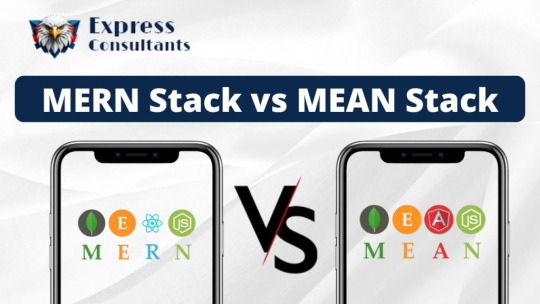
“In the world of web development, the choice of stack can make or break a project.” This statement might sound bold, but it’s spot on. The stacks you choose dictate how flexible, scalable, and efficient your application can be.
0 notes
Text
Full-Stack Web Development Course: A Real-World Guide
Full-stack web development is a skill that is in high demand. It allows you to create and maintain visually appealing and functional websites.
In this article, we will look at what full-stack web development is, what skills you need to become a full-stack web developer, and some of the best full-stack web development courses available.
What is Full-Stack web development?
Full-stack web development is the process of developing a website from the ground up. This includes both the front-end and the back-end of the website. The front end is what the user sees and interacts with, while the back end is what powers the website and makes it work.
Skills You Need to Become a Full-Stack Web Developer
In addition to a strong understanding of front-end and back-end development, there are a few other skills that you will need to become a full-stack web developer. These include:
Problem-solving skills: As a full-stack web developer, you will be responsible for solving a variety of problems, both technical and non-technical. You need to be able to think critically and come up with creative solutions to problems.
Communication skills: You will need to be able to communicate effectively with both clients and other developers. You need to be able to understand and explain technical concepts in a way that non-technical people can understand.
Organizational skills: As a full-stack web developer, you will be working on multiple projects simultaneously. You need to be able to manage your time and resources effectively.
Best Full-Stack Web Development Courses
There are many great, full-stack web development courses available online. Here are a few of the best:
- The Web Developer Bootcamp by Colt Steele
- Full Stack Web Developer Nanodegree by Udacity
- Full-Stack Web Development with React by The Hong Kong University of Science and Technology on Coursera
- Full Stack Web Development Specialization by The Hong Kong University of Science and Technology on Coursera
- The Complete 2021 Web Development Bootcamp by Dr. Angela Yu on Udemy.
- Complete Full stack Web Development Course by AnA Academy
Conclusion
Full-stack web development is a challenging but rewarding career. If you are interested in learning how to build websites from the ground up, then a full-stack web development course is a great place to start.
AnA Academy, the leading full-stack developer course provider, is a great place to start if you want to learn how to become a full-stack developer. Their comprehensive course, experienced instructors, and support resources will assist you in gaining the skills required to succeed in this expanding field.
#django course in madurai#python course in madurai#full stack developer course in madurai#jsp course in madurai#mean stack developer course in madurai#mern stack course developer in madurai#laravel course in madurai
1 note
·
View note
Text
Full-Stack Web Development Company - Comprehensive Guide
Explore the full range of services offered by a web development company, from UI/UX design to back-end development, in this detailed guide.
0 notes
Text
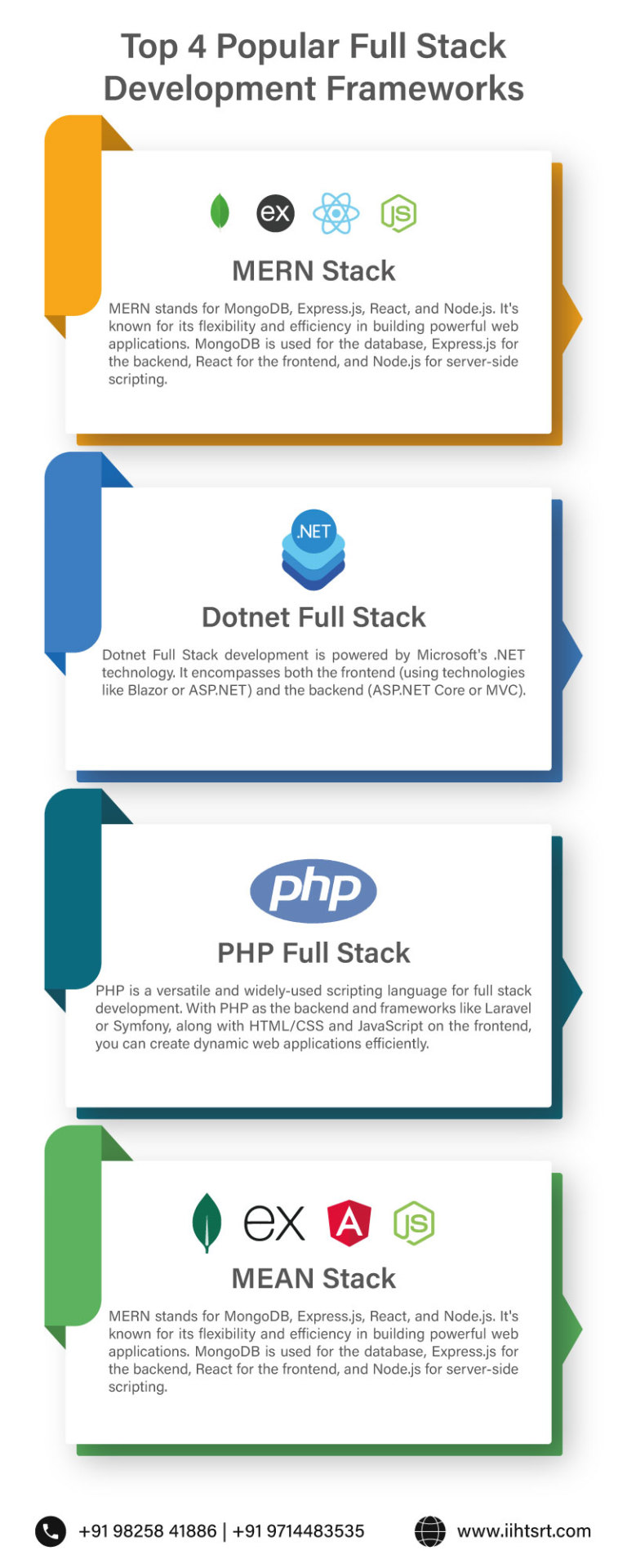
Discover Surat's exciting Full Stack Development courses! Learn PHP, Dotnet, MEAN Stack, or MEARN Stack for a tech-tastic journey to coding stardom. Hands-on fun, expert guidance, and certificates included. Enroll today!
#MERN Stack Training Course#Dotnet Full Stack Developer Course#MEAN Stack Mastery Surat#full stack developer course#full stack course
0 notes
Text
Transforming Businesses with DI Solutions: Innovative IT Expertise
Transform your business with DI Solutions

In the ever-evolving digital landscape, businesses must harness cutting-edge technology to remain competitive. At DI Solutions, we specialize in driving business transformation through advanced IT solutions and expert services. Our dedication to innovation and excellence has empowered numerous clients to achieve their goals and excel in their industries.
Innovative IT Solutions DI Solutions excels in providing tailored IT solutions that meet each client's unique needs. Our services include custom software development, mobile app creation, web development, and UI/UX design. By leveraging the latest technologies, we deliver state-of-the-art solutions that enhance growth and efficiency.
Expert Team of Professionals Our team consists of highly skilled professionals—creative designers, experienced developers, and strategic problem-solvers. We emphasize continuous learning to stay at the forefront of industry trends and technological advancements, ensuring that our clients receive the most effective and innovative solutions.
Global Reach and Impact
With over a decade of experience, DI Solutions has made a significant impact globally, partnering with more than 120 clients across North America, Europe, Asia, and Australia. Our extensive global presence demonstrates our capability to provide exceptional IT services that address diverse business needs.
Client-Centric Approach
At DI Solutions, clients are central to our mission. We take the time to understand their business objectives, challenges, and requirements, enabling us to deliver customized solutions that surpass expectations. Our client-centric approach ensures we provide not just what is needed but what drives success and growth.
Comprehensive IT Services
Our service offerings include:
Custom Software Development: Tailored software solutions for optimal efficiency and performance.
Mobile App Development: Innovative mobile applications for Android and iOS platforms.
Web Development: Expert web development to create responsive and user-friendly websites.
UI/UX Design: Engaging user interfaces that enhance the overall user experience.
Quality Assurance: Rigorous testing to ensure the highest quality standards.
DevOps Services: Streamlined operations through integrated cultural philosophies, practices, and tools.

Join Hands with DI Solutions
Partner with DI Solutions to harness the power of innovative IT expertise. Whether you’re a startup aiming to establish a presence or an established business seeking new heights, we have the solutions and expertise to propel you forward.
For more information, visit our website or contact us directly. Let’s embark on a journey of transformation and growth together.
Transform your business with DI Solutions – where innovation meets excellence.
Contact Us Website: https://disolutions.net/ Email: [email protected] , Call: 91-9904566590 , B-301, 307, 406 Apex Commercial Center, Varachha Road, Nr. Yash Plaza, Surat, Gujarat,India-395006.
youtube
#disolutions #DI Solutions #Hire Angular.js Developers #Hire React.js Developers #Hire Vue.js Developers #Hire UI/UX Developers #Hire .NET Developers #Hire Node.js Developers #Hire Laravel/PHP Developers #Hire Android Developers #Hire IOS Developers #Hire Ionic Developers #Hire React Native Developers #Hire Full Stack Developers #Hire MERN Stack Developers #Hire MEAN Stack Developers #Mobile App Development #Web Development #UI/UX Design #Quality Assurance #DevOps Services
2 notes
·
View notes
Text
DigitIndus Technologies Private Limited
DigitIndus Technologies Private Limited is one of the best emerging Digital Marketing and IT Company in Tricity (Mohali, Chandigarh, and Panchkula). We provide cost effective solutions to grow your business. DigitIndus Technologies provides Digital Marketing, Web Designing, Web Development, Mobile Development, Training and Internships
Digital Marketing, Mobile Development, Web Development, website development, software development, Internship, internship with stipend, Six Months Industrial Training, Three Weeks industrial Training, HR Internship, CRM, ERP, PHP Training, SEO Training, Graphics Designing, Machine Learning, Data Science Training, Web Development, data science with python, machine learning with python, MERN Stack training, MEAN Stack training, logo designing, android development, android training, IT consultancy, Business Consultancy, Full Stack training, IOT training, Java Training, NODE JS training, React Native, HR Internship, Salesforce, DevOps, certificates for training, certification courses, Best six months training in chandigarh,Best six months training in mohali, training institute
Certification of Recognition by StartupIndia-Government of India
DigitIndus Technologies Private Limited incorporated as a Private Limited Company on 10-01-2024, is recognized as a startup by the Department for Promotion of Industry and Internal Trade. The startup is working in 'IT Services' Industry and 'Web Development' sector. DPIIT No: DIPP156716
Services Offered
Mobile Application Development
Software development
Digital Marketing
Internet Branding
Web Development
Website development
Graphics Designing
Salesforce development
Six months Internships with job opportunities
Six Months Industrial Training
Six weeks Industrial Training
ERP development
IT consultancy
Business consultancy
Logo designing
Full stack development
IOT
Certification courses
Technical Training
2 notes
·
View notes
Text
Pseudo-historical project about 1912 unit record equipment computation aka the "Symbolic Analyst Processor" full stack!
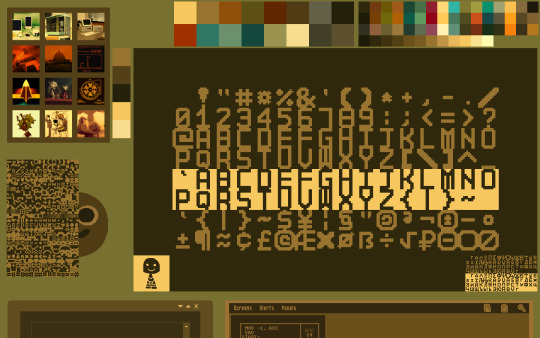
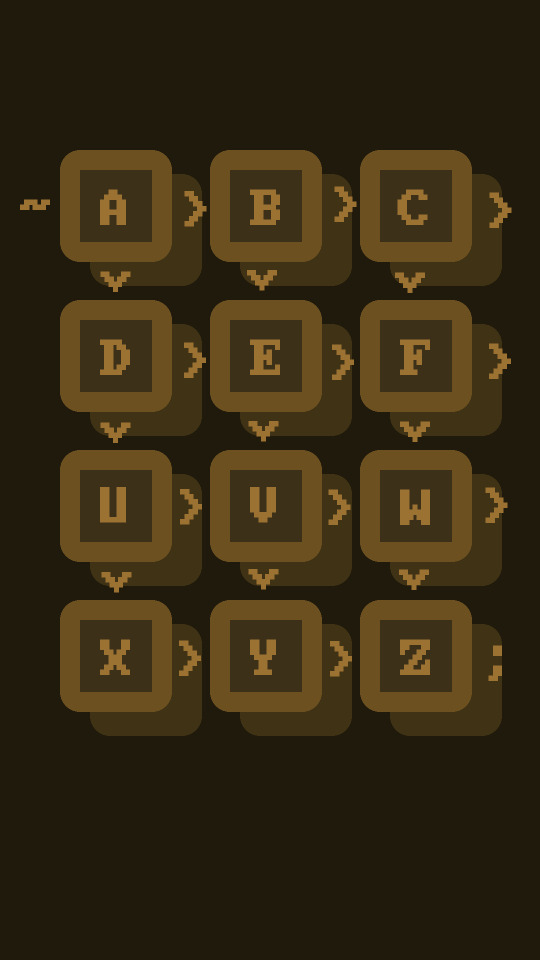
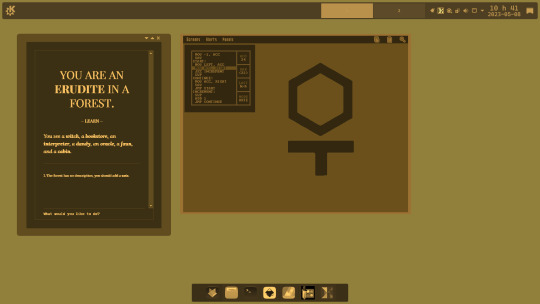
(above pictures emulate the looks of what this tech stack documentation and actual use may look like, still very early in the process though)
It is still coming together by my head as I write infodump notes and research various aspects of the whole time, (including the WIMP & MERN/MEAN stack) but yk, things are coming together nicely to give some milestone project mid-way between my current phase in life and the next where I go develop a fully alternative INTJ lively stack of tools. Explanations, history dives, lively reaction studies and a couple more content suggestions related to it are on the way.
Behold, the infodumps
"Top-bottom and back up workflow" 1910 / 1912 Unit Record Equipment Tabulator Computation "Bundle" Project (Pflaumen & Utalics' SymbolicAnalystProcessor)
Information Processing Language / LISP 1.5 / Bel, A-BASIC / DIBOL, Spreadsheets, Cellular Automaton, COS-310, magnetic tape storage too, TECO / VIM, Assembly, Wirebox, Tabulator, Alphanumeric Interpreter, Printer, RTTY device, Data Recording, Bulk Data Processing Indexed Cards, 60-64 entries Deque, 4K Direct-use RAM, 12K * 24 storage devices, Phonebook, Timeclock, DateTime Calendar, Programmable, Statistics, Demographics, Voting, Ledger, Journal, Logging, Rolodex, 12 Generic-use Registers & 4 Special Registers, Catalog, ~16 Keys Pad, Customized Hexadecimal Numeric Representation for "MachineCode" Hexdumps, 4*12 bits per page of data, Macros, Paracosm, may be useful for Military & Civilian Uses, Electrical Energy (and possibly incorporates some mechanical energy too), Nouns & Verbs, "Vector" XY plotter, Lambda Calculus / Panini Grammar / Universal Turing Machine Thesis, Rotors, Ural TriodeVaccumTube "Mainframe", Interactive-Use, Hypertext Interactive Video Terminal, Memex, Modem, Electric + Radio Telegraphy, Document-processing, Word-processing, Orange Plasma Touchscreen Terminal, Time-sharing, Cash Register, Bank, Automatic Teller Machine, Vending Machine, Oracle, Typewriter / Selectric, IBM 701, IBM 1440, IBM 403, IBM System/360, OpenPOWER, F#, IBM Tellum, MUD, TextWorld, solo text-adventures, Email, AIX, z/OS, Linux for IBM mainframes, Symbolic Processing System, Autocoder, modular, IBM Lotus Suite, interface with KDE or CDE, paper handling equipment, Addventure, 12-bit basic data unit as designated word, Distributed Interactive System, VeneraFS (cladogram Parade+DolDoc), GNU Hurd / MINIX3-style Microkernel, either permissive FLOSS license or public domain waiver, extensive documentation, printed illustrated booklets, music-playback, emulator / compiler / bytecode / interpreter, analog media-friendly, mostly for didactic tinkering educational uses, multilingual reconfigurable programming, HTML+CSS, Markdown, Argdown, DMA, hardware-friendly, software development environment for direct-access programmers and aesthetic designers, sub-version control system like Git, various hardware & software implementations, museum / observatory Toymaker story, constructed languages / imaginative paracosm influences around the immersive in-world lore of the "16^12" pseudo-historical setting…
Back to the point
The list is far from exhaustive or finished, as life is so much more than meets the eye. But this should be a good start to remind myself what I am working towards, a full revamp of the last ~120 years of history with much attention and care put into making it as satisfying to me as possible, despite the very probable scenario where people take the ideas and incorporate only some of such "modules" in their own workflows. Which is fine but not taking the whole package (and only specific modules) is eventually gonna be a major learning experience for me considering the reason I revamp it all beyond control freak stuff is literally to provide less exclusive / less invasive tools that anyone can learn and customize despite being very... idiosyncratic yk.
Still welcoming suggestions and constructive criticism for such big time, I hope those textual infodumps I do every so often don't bother you too much... Cya soon!
5 notes
·
View notes
Text
The Essential Tools Every MERN/MEAN + AI Developer Should Know
As web development evolves, the need for full-stack developers with expertise in MERN (MongoDB, Express.js, React, Node.js) and MEAN (MongoDB, Express.js, Angular, Node.js) stacks is growing rapidly. These technologies, combined with Artificial Intelligence (AI), enable developers to build smart, responsive, and data-driven applications. To excel in this domain, developers need to master a set of essential tools that allow them to create robust and scalable AI-powered web applications.
In this blog, we’ll cover the most crucial tools every MERN/MEAN + AI developer should know, categorized into backend, frontend, database, and other development tools. If you’re taking a MERN stack course or a full stack web development course, mastering these tools will make you stand out in the field.
Backend Development Tools
1. Node.js
Node.js is at the core of both MERN and MEAN stacks. It enables developers to execute JavaScript code on the server, allowing full-stack JavaScript development. Its non-blocking architecture makes it perfect for real-time applications and handling large amounts of data. Whether you're enrolled in a full stack development course or a software development course, mastering Node.js will give you the skills necessary to handle high-demand applications.
2. Express.js
If you're pursuing a full stack developer training or taking a MERN stack developer course, you'll encounter Express.js — a fast, minimalist web framework for Node.js. Express simplifies backend development by providing essential features like routing, middleware integration, and easy API creation. This makes it an essential tool for building RESTful APIs and integrating AI features into web applications.
3. Brain.js
For developers integrating AI features like pattern recognition, Brain.js is a valuable library. It's ideal for those enrolled in an Artificial Intelligence Course or exploring AI Courses & Tutorials. Brain.js simplifies the process of building neural networks in JavaScript, allowing developers to integrate AI into their MERN/MEAN projects easily.
4. TensorFlow.js
For more advanced AI implementations, TensorFlow.js is a go-to library. It allows developers to develop, train, and run machine learning models in JavaScript. If you're looking for the best AI courses for beginners, TensorFlow.js is a great tool to get started with. By integrating it into your backend using Node.js, you can run sophisticated AI models for tasks like image recognition or predictive analytics.
Front End Development Tools
5. React
If you're pursuing a MERN stack course, React is the frontend framework you'll need to master. React’s component-based architecture is perfect for building dynamic UIs, and it integrates seamlessly with AI features like real-time data rendering. React’s ecosystem, including tools like Redux for state management and React Hooks for handling state and side effects, makes it an excellent choice for building AI-driven interfaces.
6. Angular
For those enrolled in a MEAN stack program or a full stack web development course, Angular is the go-to framework. Angular's two-way data binding, dependency injection, and RxJS (Reactive Extensions for JavaScript) make it ideal for building single-page applications (SPAs) with real-time AI features such as data-driven visualizations and predictive analytics.
Database Tools
7. MongoDB
A central part of both MERN and MEAN stacks, MongoDB is a NoSQL database designed to store unstructured data. Its flexibility makes it ideal for AI-powered applications that need to manage large datasets, such as user behavior logs or real-time analytics. If you're studying in a MERN stack developer course, MongoDB will be the primary database you'll work with.
8. MySQL
For developers working with structured data, MySQL is a strong choice. This relational database is often used in combination with AI tools like TensorFlow when handling structured data such as user accounts, transactions, and logs.
Other Essential Tools
9. Visual Studio Code (VS Code)
Visual Studio Code is an essential tool for any developer. It offers built-in Git support, a powerful integrated terminal, and a wide array of extensions for JavaScript, Node.js, and AI.
10. AWS (Amazon Web Services)
As cloud computing becomes integral to web development, AWS is a must-know platform. With services like Amazon EC2 for hosting, S3 for storage, and Lambda for serverless computing, AWS provides the infrastructure to scale your applications.
11. Postman
Postman is an API testing tool that simplifies interaction with your backend services. If you're developing APIs to integrate AI features, Postman is indispensable for testing and validating requests.
12. Docker
Docker allows you to containerize your application, ensuring it runs consistently across different environments. It's an essential tool for modern development practices, especially for those pursuing a full stack web developer course.
13. GitHub
Version control is key for any web development project, and GitHub is the industry standard for collaborative development.
14. Kubernetes
Kubernetes is essential for automating the deployment, scaling, and management of containerized applications.
15. Swagger
Swagger is an open-source tool used to document APIs, making it easier to communicate how your backend services work.
Conclusion: Master These Tools with TechEntry
The tools mentioned above form the backbone of modern MERN/MEAN + AI development. Whether you're building dynamic, AI-powered web applications or managing large datasets, mastering these tools is crucial for success in today’s tech landscape.
If you’re ready to dive deeper and learn how to use these tools effectively, TechEntry offers comprehensive courses like the MERN stack development course, full stack web development course, and Artificial Intelligence Course. These courses are designed to help you master the essential tools and techniques to become a skilled MERN/MEAN + AI developer.
Why TechEntry? Hands-on Learning: Gain practical experience through real-world projects. Industry-Standard Tools: Learn the latest tools and technologies such as Node.js, MongoDB, TensorFlow, AWS, and more. Flexible Learning Options: Whether you prefer online or offline learning, we offer both to suit your schedule. Career Support: We offer placement assistance to help you land your dream job as a full stack developer or AI expert.
Take the next step in your career and unlock your potential with TechEntry. Whether you're looking for the best Frontend development course, best backend development course, full stack developer training, or the best AI courses for beginners, our programs are designed to equip you with the skills businesses need today.
#fullstackdevelopercourse#softwaredevelopmentcourse#MERN stack course#Full Stack Course#Full Stack Development Course#MERN/MEAN Full Stack Developer Course#AI Full Stack Engineer!
0 notes
Text

Crack the Code- Best MEAN Stack Course for Future Developers | Sensation Solutions
Unlock the secrets of web development with our best MERN Stack course, hailed as the best choice for aspiring developers. Crack the code to becoming a full-stack MERN developer with our comprehensive training. Dive into real-world projects, gain hands-on experience, and shape your future. Join Sensation Solutions for an immersive learning journey toward MERN stack mastery.
#Best MERN stack course#MERN Stack Course in Chandigarh & Mohali#full stack mern developer course#best full stack web development#advanced web designing course#best MEAN Stack course
1 note
·
View note
Text
The Future of Full Stack Development: Envisioning Cutting-edge Trends and Innovations
In the rapidly evolving digital era, the concept of full stack development has emerged as a critical component for modern businesses. Embracing full stack development means embracing the ability to handle both frontend and backend development tasks, effortlessly bridging the gap between different layers of technology. By having a holistic understanding of all aspects of software development, full stack developers hold the key to unlocking innovation, efficiency, and adaptability in the tech industry.
Staying ahead of the curve is imperative for any developer, and full stack development plays a vital role in enabling professionals to do just that. In this article, we will explore the realm of full stack development, its evolution over time, and the cutting-edge trends and innovations that are shaping its future.

II. Understanding Full Stack Development
Defining full stack development and its evolution over time
Full stack development refers to the practice of handling both frontend and backend development tasks, making developers proficient in multiple technologies. While the term "full stack" was initially coined to describe web development, its scope has expanded to encompass a broader variety of technologies and platforms, including mobile applications.
Throughout its evolution, full stack development has transformed from being focused on traditional web development stacks to embracing modern and versatile frameworks. This shift has allowed developers to have a more comprehensive understanding of the entire software development process.
Importance of full stack developers in today's tech industry
The demand for full stack developers has soared in recent years, primarily due to their ability to handle various development tasks efficiently. Full stack developers possess a unique skill set that allows them to contribute to different stages of the development lifecycle, making them highly sought after by organizations looking to streamline their processes.
By being capable of working on both the frontend and backend, full stack developers bring synergy to teams, facilitating seamless collaboration and reducing the need for heavy dependencies on specialized roles. Their versatility empowers organizations to innovate rapidly and respond effectively to changing market demands.
III. The Evolution of Full Stack Development
Early days: Traditional web development stacks
In the early days of full stack development, traditional web development stacks like LAMP (Linux, Apache, MySQL, PHP) and WAMP (Windows, Apache, MySQL, PHP) dominated the scene. These stacks provided developers with the foundations to build dynamic and interactive websites, integrating various frontend elements with backend functionalities.
Shifting to modern stacks: MEAN, MERN, and more
As web technologies evolved, modern full stack development stacks like MEAN (MongoDB, Express.js, Angular, Node.js) and MERN (MongoDB, Express.js, React, Node.js) emerged. These stacks capitalized on the power of JavaScript to provide developers with a unified language for both frontend and backend development. These modern stacks enable rapid development and enhance code reusability and maintainability.
The rise of versatile frameworks and libraries
The continuous innovation in the tech industry has given rise to versatile frameworks and libraries that augment the capabilities of full stack developers. Frameworks like Laravel, Ruby on Rails, and Django simplify backend development, while frontend frameworks like React, Angular, and Vue.js provide efficient solutions for creating dynamic user interfaces. These frameworks, combined with powerful libraries like Redux and Bootstrap, empower full stack developers to create robust, user-friendly, and visually appealing applications.
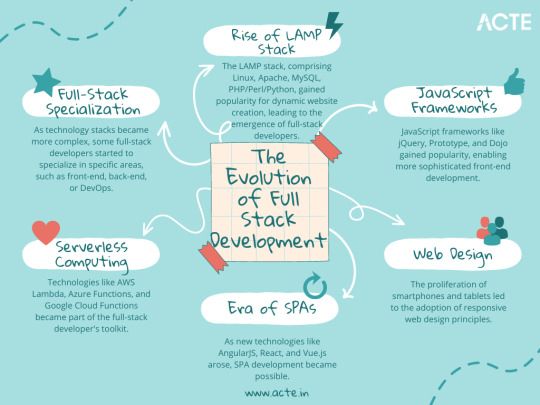
IV. Key Technologies Shaping the Future of Full Stack Development
Artificial Intelligence and Machine Learning integration
Artificial Intelligence (AI) and Machine Learning (ML) are revolutionizing full stack development by enabling developers to create intelligent and data-driven applications. Integration of AI and ML technologies into full stack development empowers applications to analyze vast amounts of data, make informed decisions, and provide personalized experiences to users.
Blockchain technology and its impact on full stack development
Blockchain technology is another key innovation that is transforming the landscape of full stack development. Its decentralized and immutable nature brings enhanced security, transparency, and traceability to applications. Full stack developers are leveraging blockchain to build secure and trustless applications for various industries, such as finance, supply chain, and healthcare.
Augmented Reality/Virtual Reality and its potential applications
Augmented Reality (AR) and Virtual Reality (VR) are emerging technologies that hold immense potential for full stack development. These technologies offer unique opportunities to create immersive and engaging user experiences. Full stack developers can harness AR and VR to build applications for gaming, training simulations, virtual tours, and other interactive experiences.
V. Exploring Advanced Front-end Development
Progressive Web Apps and their advantages
Progressive Web Apps (PWAs) are a cutting-edge advancement in full stack development that combines the best features of web and mobile applications. PWAs offer fast and reliable performance, offline capabilities, and push notifications, providing users with an app-like experience directly from their browsers. Full stack developers can leverage frameworks like React and Angular to build PWAs that support cross-platform compatibility and deliver seamless user experiences.
The role of JavaScript frameworks: React, Angular, Vue.js
React, Angular, and Vue.js are a few examples of JavaScript frameworks that have completely changed front-end development.These frameworks provide developers with the tools and components necessary to build interactive and responsive user interfaces. Full stack developers proficient in these frameworks can create dynamic web applications and enhance user experiences with ease.
WebAssembly: Unlocking high-performance web applications
WebAssembly (WASM) is an innovative technology that allows full stack developers to run high-performance applications directly in the browser. With WebAssembly, developers can compile languages like C, C++, and Rust into a binary format that can execute at near-native speeds. This capability enhances the performance and versatility of web applications, opening up new possibilities for full stack development.
VI. Innovative Back-end Developments
Serverless architecture and its benefits
Serverless architecture is transforming the way backend development is approached. With serverless computing, full stack developers can focus more on the core functionality of their applications, without the need to manage the infrastructure. Serverless platforms like AWS Lambda and Azure Functions provide scalability, cost efficiency, and ease of deployment, allowing developers to build and deploy applications more rapidly.
Microservices: Enhancing scalability and flexibility
Microservices architecture is gaining popularity in full stack development due to its ability to enhance scalability and flexibility. By breaking down applications into smaller, modular services, full stack developers can independently develop, test, deploy, and scale different components of the application. Microservices enable teams to collaborate more effectively, improve fault tolerance, and achieve faster time-to-market.
Containerization: Docker and Kubernetes revolution
Containerization has revolutionized the deployment and management of applications. Docker, combined with orchestration tools like Kubernetes, allows full stack developers to package applications along with their dependencies into lightweight and portable containers. This approach enables seamless deployment across different environments and simplifies scaling and maintenance, making it a preferred choice for modern full stack development.
VII. The Convergence of DevOps and Full Stack Development
Understanding the collaboration between developers and operations
DevOps has emerged as a crucial discipline that emphasizes seamless collaboration between development and operations teams. In the context of full stack development, this collaboration becomes even more critical, as developers are responsible for both frontend and backend operations. By adopting DevOps principles, full stack developers can streamline processes, accelerate delivery, and maintain a high level of quality in their applications.
Continuous Integration and Continuous Delivery (CI/CD) pipelines
Continuous Integration (CI) and Continuous Delivery (CD) pipelines are fundamental practices for full stack development teams. CI/CD pipelines automate the process of integrating code changes, running tests, and delivering applications to production environments. By embracing CI/CD pipelines, full stack developers can ensure faster, more frequent releases while maintaining the stability and quality of their applications.
Infrastructure as Code (IaC) practices
Infrastructure as Code (IaC) is a key practice that enables full stack developers to manage infrastructure programmatically, treating it as code. Using tools like Terraform and CloudFormation, developers can define and provision infrastructure resources declaratively. This approach enhances scalability, reproducibility, and consistency, and reduces the chances of manual errors, making infrastructure management more efficient and reliable.
VIII. The Impact of Cloud Computing on Full Stack Development
Cloud-native development: Advantages and challenges
Cloud computing has transformed the landscape of full stack development. Full stack developers can leverage cloud platforms like AWS, Azure, and Google Cloud to build scalable, reliable, and cost-effective applications. Cloud-native development allows developers to take advantage of cloud services, such as storage, databases, and machine learning, without the need for extensive infrastructure management. However, challenges related to security, vendor lock-in, and latency must be carefully addressed when adopting cloud-native approaches.
Leveraging Platform-as-a-Service (PaaS) solutions
Platform-as-a-Service (PaaS) solutions offer full stack developers a simplified and streamlined environment to develop, deploy, and manage applications. PaaS platforms, like Heroku, Cloud Foundry, and Google App Engine, abstract away the underlying infrastructure, allowing developers to focus solely on application logic. PaaS solutions accelerate development cycles, remove the burden of infrastructure management, and enable developers to iterate quickly.
Serverless computing and its implications
Serverless computing, offered by cloud providers such as AWS Lambda and Azure Functions, has gained significant attention in recent years. With serverless computing, full stack developers can focus on writing small, event-driven functions that automatically scale based on demand. This approach significantly reduces operational overhead, improves resource utilization, and allows developers to build highly scalable and cost-efficient applications.
IX. Full Stack Development for Mobile Applications
Native vs. Cross-platform development
When it comes to mobile application development, full stack developers face the choice between native and cross-platform development. Native development involves building applications specifically for a particular platform, such as iOS or Android, using platform-specific programming languages. Cross-platform development, on the other hand, allows developers to write code once and deploy it on multiple platforms. While native development offers maximum performance and access to platform-specific features, cross-platform development provides greater code reusability and faster development cycles.
Mobile frameworks: React Native and Flutter
React Native and Flutter are two popular mobile frameworks that have gained significant traction in the full stack development community. React Native, based on JavaScript, and Flutter, based on Dart, provide the ability to build high-quality native mobile applications using a single codebase. These frameworks offer reusable components, hot reloading, and a rich ecosystem of libraries and tools, empowering full stack developers to create stunning and performant mobile apps rapidly.
Mobile web development: Challenges and opportunities
Mobile web development enables full stack developers to create web applications optimized for mobile devices. While this approach provides the advantage of platform independence and ease of maintenance, it poses challenges like limited access to device features and potential performance limitations. However, leveraging responsive design, progressive enhancements, and caching mechanisms, full stack developers can overcome these challenges and deliver seamless mobile experiences through web applications.
X. The Future of User Experience (UX) in Full Stack Development
Voice User Interfaces (VUIs) and Natural Language Processing (NLP)
Voice User Interfaces (VUIs) and Natural Language Processing (NLP) are transforming the way users interact with applications. With advancements in technologies like Speech Recognition and Natural Language Understanding, full stack developers can build applications that respond to voice commands and understand natural language. By integrating VUIs and NLP, developers can provide intuitive, hands-free user experiences, enabling better accessibility and increased user engagement.
Augmented Reality (AR) and User Interface (UI) integration
Augmented Reality (AR) is reshaping the user experience landscape by overlaying virtual content onto the physical world. Full stack developers can fuse AR technology with user interfaces, creating interactive and immersive experiences. By integrating AR into applications, developers can enhance visualization, spatial awareness, and engagement, opening up new possibilities in areas such as gaming, retail, and education.
Intelligent chatbots and personalized user experiences
Intelligent chatbots powered by Artificial Intelligence (AI) are becoming increasingly prevalent in applications. Full stack developers can leverage AI technologies like Natural Language Processing and Machine Learning to create chatbots capable of understanding user intents and providing personalized responses. By incorporating chatbots into applications, developers can automate customer support, improve user interactions, and deliver tailored experiences at scale.
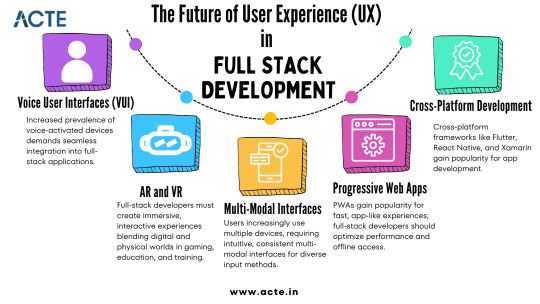
XI. Security Considerations in Full Stack Development
Protecting applications against data breaches and cyberattacks
The most important consideration in full stack development is security. Developers that work across the entire stack must be well-versed in secure coding techniques and have a solid grasp of typical vulnerabilities and attack vectors. Developers may safeguard apps against data breaches and cyberattacks, protecting user information and preserving the integrity of the systems they create, by integrating secure authentication mechanisms, input validation, encryption methods, and routine security audits.
Implementing secure coding practices
Secure coding practices are essential to mitigate security risks in full stack development. Developers must adhere to industry best practices, such as validating user inputs, using parameterized queries to prevent SQL injection, and employing access control mechanisms to ensure proper authorization. By following secure coding principles, full stack developers can minimize the likelihood of introducing vulnerabilities and maintain the confidentiality, integrity, and availability of applications.
Incorporating encryption and authentication mechanisms
Encryption and authentication mechanisms play a critical role in securing full stack applications. Full stack developers should implement encryption protocols like SSL/TLS to protect data transmission and storage. Additionally, robust authentication mechanisms, such as multi-factor authentication and OAuth, should be utilized to ensure that only authorized users can access sensitive resources. By incorporating these security measures, developers can fortify applications against unauthorized access and data breaches.
XII. Scaling Full Stack Applications for the Modern Era
Horizontal and vertical scaling: Pros and cons
Scaling is a fundamental aspect of full stack development to ensure applications can handle increased user demand. Full stack developers can choose between horizontal scaling, which involves adding more instances of servers to distribute the workload, and vertical scaling, which involves increasing the resources of existing servers. Horizontal scaling provides better fault tolerance and can handle rapid spikes in traffic, while vertical scaling offers better performance and reduced overhead. Choosing the appropriate scaling strategy depends on the unique requirements and architecture of the application.
Optimizing performance with caching and load balancing
Optimizing performance is crucial in full stack development. By implementing caching mechanisms, such as Content Delivery Networks (CDNs) and in-memory caching, full stack developers can minimize server response times and reduce the load on the backend infrastructure. Additionally, load balancing techniques distribute traffic across multiple servers, preventing overload and ensuring optimal performance. By leveraging caching and load balancing strategies, developers can improve scalability, reliability, and user experience.
Monitoring and error handling strategies
The vitality and stability of full stack applications depend on monitoring and error management. Full stack developers should use reliable monitoring tools that offer in-the-moment visibility into the performance, resource usage, and any problems of the application. Developers can proactively discover and address issues by utilizing logging, alerting, and automated error handling techniques, which reduces downtime and improves the user experience overall.
XIII. Learning Resources
Given that there is so much to learn and comprehend, staying current with the most recent full stack development trends and breakthroughs can be a challenging undertaking. Fortunately, there are many tools at their disposal to assist developers in keeping up with the most recent developments and technology. These sources include blogs, books, tutorials, and Full Stack Developer courses.

In conclusion, any software developer must stay current with the most recent trends and advances because full stack development is a field that is continuously changing in order to produce better, more effective solutions. We have examined some of the most recent full stack development trends and innovations in this blog, including low-code/no-code development, automation, artificial intelligence, open source platforms, cloud-based solutions, cross-platform development, containers, blockchain development, GraphQL, data-driven solutions, augmented reality, and virtual reality applications. There are several resources accessible for those who want to learn more about full stack development, including online courses, tutorials, books, and blogs.
6 notes
·
View notes
Text
Why Luminar Technolab is the Best Software Institute in Kochi for Future Tech Experts
With the rapidly evolving nature of the digital era in the present, choosing the right software training institute can be a game-changer for your future. With technology leaving its footprint in every sector, talented individuals with expertise in fields such as software development, data science, artificial intelligence, and web development have never been more in demand. And when it comes to bridging the gap between theoretical education and real-time applications, Luminar Technolab is a clear winner. In fact, it's not only considered the top software training institute in Kochi, but for good reason.
This blog takes a look at why Luminar Technolab has become so famous and how it can transform your career journey in the IT sector.
1. A Consistent Track Record of Excellence
Luminar Technolab is not just another name in the sea of software training institutes. It has been well-reputed in recent years for consistently offering industry-relevant training. There are hundreds of students who were once lost to understand their career paths and are today placed in top tech companies in India and abroad, thanks to Luminar's well-structured courses and practical teaching approach.
Unlike traditional training institutes, Luminar focuses on:
In-depth curriculum
Industry-standard tools and techniques
Real-time projects
Soft skills and placement training
This comprehensive focus on development makes it one of the most career-centric and best software training institutes in Kochi.
2. Industry-Aligned Courses That Matter
Whether you’re a beginner stepping into the tech world or a graduate looking to upskill, Luminar Technolab offers a variety of industry-focused courses tailored to meet current and future demands.
Popular Courses Include:
Full Stack Python Development
Data Science & Machine Learning
Java Full Stack Development
Flutter Mobile App Development
Software Testing (Manual & Automation)
MEAN / MERN Stack Development
AWS, DevOps, and Cloud Computing
Business Intelligence Tools (Power BI, Tableau)
These courses are not certifications, they are career accelerators.
3. Experienced Mentors & Trainers
One of Luminar Technolab's best supporting pillars is its extremely skilled trainers. They aren't instructors, they're project professionals with extensive work experience in actual projects. Mentors are aware of what employers need and design training modules that neatly plug into practical necessities.
Each trainer has an individual approach, mentoring students not only on technical matters but also on career development in technology.
Their mentorship is one of the main reasons why Luminar is consistently voted the best software institute in Kochi by its alumni.
4. Hands-On Learning with Real-Time Projects
In today's job market, being smart is no longer enough. Employers want candidates who can "hit the ground running."
That's why Luminar Technolab emphasizes a lot on project-based learning. From building websites to working with data sets and deploying applications on the cloud, students get an opportunity to work on real-life, industry-relevant projects.
These projects not only reinforce learning but also build confidence. Even some students make use of project work as a portfolio to impress the recruiters during interviews.
5. Amazing Placement Support
What truly makes Luminar stand out as a favorite among students is its outstanding placement support. The institute boasts great connections with over 100+ hiring partners in the technology industry, including MNCs, startups, and mid-sized companies.
Placement support consists of:
Resume building
Interview preparation
Mock interviews
Job scheduling and notifications
Company-specific training
By this extensive guidance, students are always rematched with high-growth companies with lucrative salary packages. This frequent performance is the reason for Luminar being ranked as the best software academy in Kochi.
6. Career-Focused Approach
Not every institute is focused solely on technical training, though. Luminar has a career-first focus. From week one of instruction, focus is not only on writing code but on learning job-readiness as well.
Students are trained to:
Communicate well
Work effectively in teams
Implement Agile/Scrum methodology
Manage projects
Problem-solving and critical thinking
All these factors for career-readiness are integral to long-term success and are included in the syllabus of every course.
7. Awarded as a Reliable Training Brand
Luminar Technolab is ISO-certified and has a partnership with the National Skill Development Corporation (NSDC) and Skill India. It's a govt.-approved organization that always remains at the forefront of Kochi's tech training landscape.
These certifications not only enhance the institute's reputation but also ensure the quality of training in line with international standards.
8. Hybrid Learning Options
Another enormous advantage of choosing Luminar Technolab is flexibility. Students can enroll in:
Physical classes on the Kochi campus
Online live classes from any location in India
This combination of learning prevents geographical limitations from coming in the way of students reaching quality education. The online platforms are not static, and students receive the same level of individualized attention and guidance as offline classes.
9. Student Success Stories
No testimonial beats the success of alumni. Hundreds of Luminar alumni today work as:
Software Engineers in leading IT companies
Data Scientists in analytics companies
App Developers in startups
QA Engineers and Automation Testers in product companies
Most of them had very little programming experience but were able to build robust careers following the training at Luminar.
Their feedback is the proof that anyone can be successful if properly guided, and Luminar does it in abundance.
10. Location Advantage – In the Very Heart of Kochi
Situated in one of Kerala's technology parks, Luminar Technolab is easily accessible from any desirable location. Kochi boasts of Infopark and several tech parks, making it a smart choice for upcoming developers and data professionals.
Students get the advantage of being closely located to an emerging IT environment, getting them exposed more and with greater career opportunities.
Final Thoughts: Why Luminar Technolab is Your Best Choice
Choosing the right training institute is one of the major decisions in a techie aspirant's life. If you are looking for an institution which:
Offers job-oriented training
Offers one-to-one mentorship
Provides live projects
Has a high placement record
And is known as the best software training institute in Kochi Therefore, Luminar Technolab is your clear choice.With proper training, direction, and approach, your desired IT career is well within your reach and Luminar is here to guide you through it.
Ready to Start Your Tech Career?
Stop by www.luminartechnolab.com or pay a visit to the Kochi center to meet with a counselor and sign up for a course of your choice.
0 notes
Text
Why You Should Hire Dedicated MERN Stack Developers from Brain Inventory
In today's digital world, businesses need agile, scalable, and future-ready web applications to stay ahead of the curve. The MERN stack—comprising MongoDB, Express.js, React.js, and Node.js—is a powerful full-stack framework that helps build dynamic, high-performance web applications with unmatched speed and efficiency. However, the real key to success lies in the team behind the code.
When you hire dedicated MERN stack developers from Brain Inventory, you’re not just hiring technical talent—you’re gaining a reliable development partner with proven expertise, deep experience, and a strong commitment to delivering quality at scale.

The Power of MERN Stack Development
The MERN stack is a JavaScript-based technology stack that allows for end-to-end development using a single language across both client and server sides. This means faster development cycles, easier debugging, and a more seamless integration between the front end and the back end.
MongoDB – A flexible NoSQL database for scalable data management.
Express.js – A minimal, high-performance web server framework. React.js – A component-based library for building responsive UIs.
Node.js – A runtime environment for executing JavaScript server-side.
Together, these technologies allow developers to build secure, high-speed, and scalable applications—from eCommerce stores and SaaS products to enterprise dashboards and real-time collaboration tools.
Why Hire Dedicated MERN Stack Developers from Brain Inventory?
Choosing the right team is as important as choosing the right tech stack. At Brain Inventory, we offer you the chance to hire MERN stack developers who are not only technically skilled but also business-savvy, collaborative, and result-driven.
✅ 100% Dedicated Developers
When you hire from Brain Inventory, your project is handled by dedicated MERN developers who focus exclusively on your business goals—ensuring productivity, accountability, and consistent progress.
✅ Flexible Hiring Models
Whether you need a single developer or a full-scale remote team, Brain Inventory offers scalable hiring options—hourly, monthly, or project-based—to match your specific requirements and budget.
✅ Full-Stack Expertise
Our developers are proficient in the complete MERN stack and capable of building full-cycle applications, integrating front-end UI with back-end logic, and deploying on cloud platforms.
✅ Real-World Project Experience
From fintech to healthcare and from startups to large enterprises, our MERN stack developers have built robust applications that handle real-world complexity and scale.
What You Get When You Hire MERN Stack Developers from Brain Inventory
Brain Inventory ensures that every project benefits from
🔹 Rapid Development Cycles—Using agile methodology for faster MVPs.
🔹 Quality Code & Best Practices—We follow clean code standards and conduct regular code reviews.
🔹 Transparent Communication—Daily updates, sprint reports, and direct developer communication. 🔹 Seamless Collaboration—We integrate with your in-house teams and tools for smooth cooperation.
🔹 Post-Deployment Support—We don’t just deliver—we help you maintain and scale.
Use Cases: When to Hire Dedicated MERN Stack Developers
Hiring dedicated MERN stack developers from Brain Inventory is ideal for:
🚀 Startups building MVPs with limited resources and tight deadlines.
📱 Product-based companies requiring fast, scalable, and user-friendly web platforms.
💼 Enterprises looking to modernize legacy applications or build new microservices-based platforms.
🌍 Agencies seeking reliable offshore development partners to extend their tech teams.
Industries We Serve with MERN Stack Expertise
Our dedicated developers have successfully delivered MERN stack solutions for:
🏦 FinTech Platforms
🛍️ eCommerce & Retail Solutions
🎓 EdTech & Learning Portals
🏥 Healthcare Applications
📊 SaaS Dashboards and Analytics Tools
Whatever your domain, Brain Inventory tailors development to meet your unique business goals.
Client Success Story: Building a Scalable Marketplace Platform
One of our clients in the retail sector needed a highly interactive and scalable multi-vendor marketplace. By hiring our dedicated MERN stack developers, they were able to:
Launch a functional MVP in 60 days
Integrate real-time product tracking
Enable dynamic user dashboards
Achieve 200% performance improvement compared to their legacy platform The solution is now scaling across multiple countries—powered by MERN, delivered by Brain Inventory.
Final Thoughts
Hiring the right talent can make or break your product. By choosing to hire dedicated MERN stack developers from Brain Inventory, you get access to expert professionals who understand your business needs and have the technical skill to execute efficiently.
We bring together the power of the MERN stack with our passion for building top-quality digital products—ensuring you stay competitive, innovative, and agile in the market.
Partner with Brain Inventory and hire MERN stack developers who go beyond code to deliver success.
#Hire Dedicated MERN Stack Developers#Hire MERN Stack Developers#mern stack developers#hire dedicated mean stack developers#dedicated mern stack developers#mern stack development services#hire mean stack developers#mern stack development company
0 notes